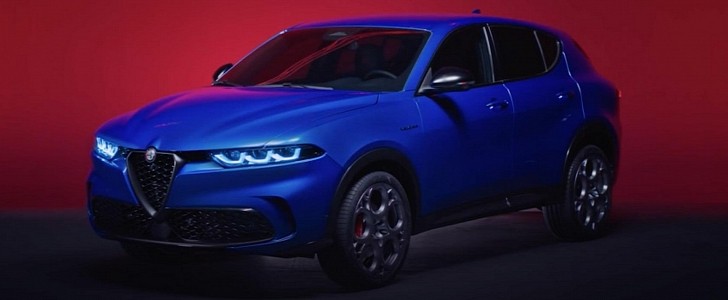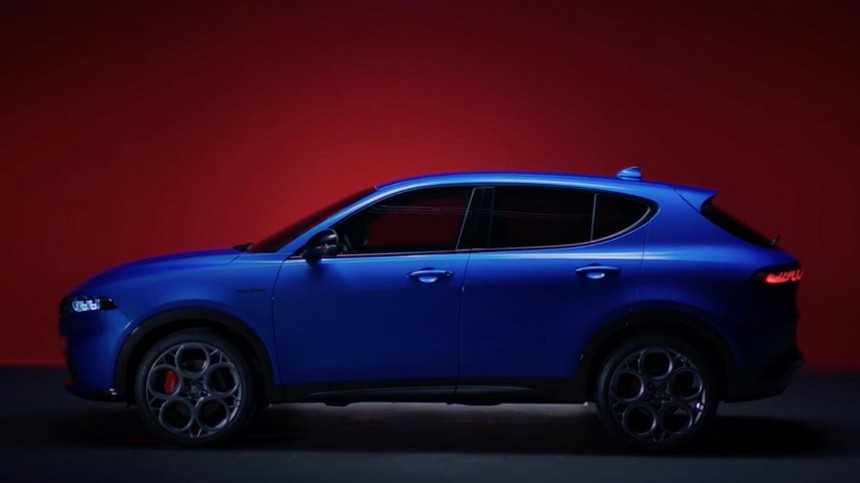The Alfa Romeo Tonale was not supposed to surprise anyone after the concept was revealed in March 2019. Yet, it did. The new compact SUV should premiere on February 8, 2022, but Stellantis allowed a video to leak. Thanks to the guys from Autogaleria.pl, we now have the images and some technical info about the new Alfa Romeo.
The Tonale seemed pretty faithful to the concept in a quick glimpse, but the truth is that the proportions of the production vehicle will make you miss the show car. The final version has longer overhangs – especially in the rear. The stance is also not ideal, with wheels that look relatively small for this car. That makes the Tonale seem less harmonious than the Tonale Concept did. It may look better in person than it does in these images.
The video that Autogaleria.pl got to watch apparently did not reveal the Tonale’s dimensions, only details about its powertrain. The SUV will have three options, all of them based on a 1.5-liter turbocharged three-cylinder derived from the 1.3 FireFly motor developed by Brazilian and Italian Fiat engineers.
When this engine was revealed, one of these engineers told us the 1.3-liter displacement was precisely what they wanted to have. Alfa Romeo must have made them change their minds.
With the more significant displacement, the engine delivers 130 ps (128 hp) and 160 ps (158 hp), but it never comes alone. The three-cylinder is either part of a 48V hybrid arrangement or is mated to an electric motor that powers the rear wheels in the plug-in hybrid version.
The more potent version of the internal combustion engine owes that to a variable geometry turbocharger. As with all hybrids, the 1.5-liter mill follows the Miller cycle, which makes the expansion stroke be longer than the compression stroke. That makes the engine slightly more efficient.
In its hybrid versions, the Tonale has a 7-speed dual-clutch gearbox with a built-in 48V 15-kW (20-hp) motor. This electric motor delivers 55 Nm (40.6 pound-feet) on its own. The plug-in hybrid adopts a 6-speed automatic transmission and counts on 275 ps (271 hp).
Europe will also have a 1.6-liter diesel option with 130 ps. Foreign markets may get a 2-liter petrol engine – possibly the same one on the Giulia and Stelvio – with 256 ps and a 9-speed automatic gearbox. Cars with this engine will also have the Q4 all-wheel-drive system. It is just not clear if it will be the plug-in hybrid or if Alfa Romeo will count only on the combustion engine for that.
The plug-in hybrid is expected to reach an all-electric urban range of up to 80 km (50 miles) thanks to a 15.5 kWh battery pack. Stellantis was sure to include “urban” there because highway speeds will probably make this range reasonably shorter.
The Tonale will have two trims (Super and T.I.) and two packs (Sprint and Veloce). It is not clear which trims will get the engine options we already mentioned.
Sadly, the new Alfa Romeo seems to perform autonowashing by mentioning that its intelligent ACC (adaptive cruise control) associated with lane centering and traffic jam assist leads to Level 2 autonomous driving. By definition, Level 2 systems are not autonomous. At best, they automate some functions but are never autonomous: they need human attention and intervention when necessary.
The reveal may answer all the questions that we still have about the Tonale. If you are not willing to wait, we suggest you visit Autogaleria.pl to check the other screenshots our Polish colleagues obtained. Even if you don’t speak Polish, the images speak for themselves.
The video that Autogaleria.pl got to watch apparently did not reveal the Tonale’s dimensions, only details about its powertrain. The SUV will have three options, all of them based on a 1.5-liter turbocharged three-cylinder derived from the 1.3 FireFly motor developed by Brazilian and Italian Fiat engineers.
When this engine was revealed, one of these engineers told us the 1.3-liter displacement was precisely what they wanted to have. Alfa Romeo must have made them change their minds.
The more potent version of the internal combustion engine owes that to a variable geometry turbocharger. As with all hybrids, the 1.5-liter mill follows the Miller cycle, which makes the expansion stroke be longer than the compression stroke. That makes the engine slightly more efficient.
In its hybrid versions, the Tonale has a 7-speed dual-clutch gearbox with a built-in 48V 15-kW (20-hp) motor. This electric motor delivers 55 Nm (40.6 pound-feet) on its own. The plug-in hybrid adopts a 6-speed automatic transmission and counts on 275 ps (271 hp).
The plug-in hybrid is expected to reach an all-electric urban range of up to 80 km (50 miles) thanks to a 15.5 kWh battery pack. Stellantis was sure to include “urban” there because highway speeds will probably make this range reasonably shorter.
The Tonale will have two trims (Super and T.I.) and two packs (Sprint and Veloce). It is not clear which trims will get the engine options we already mentioned.
The reveal may answer all the questions that we still have about the Tonale. If you are not willing to wait, we suggest you visit Autogaleria.pl to check the other screenshots our Polish colleagues obtained. Even if you don’t speak Polish, the images speak for themselves.










